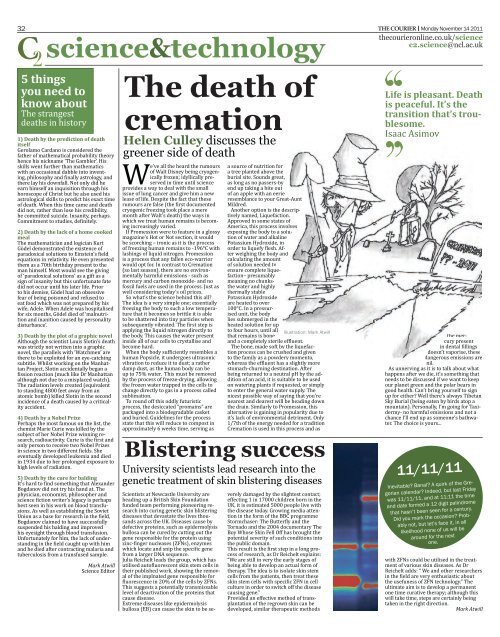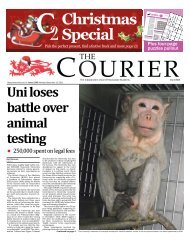You also want an ePaper? Increase the reach of your titles
YUMPU automatically turns print PDFs into web optimized ePapers that Google loves.
32 THE COURIER Monday <strong>November</strong> 14 2011thecourieronline.co.uk/sciencec2.science@ncl.ac.ukscience&technology5 thingsyou need toknow about<strong>The</strong> strangestdeaths in history1) Death by the prediction of deathitselfGerolamo Cardano is considered thefather of mathematical probability theoryhence his nickname ‘<strong>The</strong> Gambler’. Hisskills went further than mathematicswith an occasional dabble into inventing,philosophy and inally astrology, andthere lay his downfall. Not only did heearn himself an inquisition through hishoroscope of Christ but he also used hisastrological skills to predict his exact timeof death. When this time came and deathdid not, rather than lose his credibility,he committed suicide. Insanity, perhaps.Commitment to studies, deinitely.2) Death by the lack of a home cookedmeal<strong>The</strong> mathematician and logician KurtGödel demonstrated the existence ofparadoxical solutions to Einstein’s ieldequations in relativity. He even presentedthem as a 70th birthday present to theman himself. Most would see the givingof ‘paradoxical solutions’ as a gift as asign of insanity but this unfortunate fatedid not occur until his later life. Priorto his demise, Gödel had an obsessivefear of being poisoned and refused toeat food which was not prepared by hiswife, Adele. When Adele was hospitalisedfor six months, Gödel died of ‘malnutritionand inanition caused by personalitydisturbance’.3) Death by the plot of a graphic novelAlthough the scientist Louis Slotin’s deathwas strictly not written into a graphicnovel, the parallels with ‘Watchmen’ arethere to be exploited for an eye-catchingsubtitle. Whilst working on the ManhattanProject, Slotin accidentally began aission reaction (much like Dr Manhattanalthough not due to a misplaced watch).<strong>The</strong> radiation levels created (equivalentto standing 4800 feet away from anatomic bomb) killed Slotin in the secondincidence of a death caused by a criticalityaccident.4) Death by a Nobel PrizePerhaps the most famous on the list, thechemist Marie Curie was killed by thesubject of her Nobel Prize winning research,radioactivity. Curie is the irst andonly person to receive two Nobel Prizesin science in two different ields. Sheeventually developed leukemia and diedin 1934 due to her prolonged exposure tohigh levels of radiation.5) Death by the cure for baldingIt’s hard to ind something that AlexanderBogdanov did not try his hand at. <strong>The</strong>physician, economist, philosopher andscience iction writer’s legacy is perhapsbest seen in his work on blood transfusions.As well as establishing the SovietUnion as a base for research in the ield,Bogdanov claimed to have successfullysuspended his balding and improvedhis eyesight through blood transfusion.Unfortunately for him, the lack of understandingin the ield caught up with himand he died after contracting malaria andtuberculosis from a transfused sample.Mark AtwillScience Editor<strong>The</strong> death ofcremationHelen Culley discusses thegreener side of deathWe’ve all the heard the rumoursof Walt Disney being cryogenicallyfrozen; idyllically preservedin time until scienceprovides a way to deal with the smallissue of lung cancer and give him a newlease of life. Despite the fact that theserumours are false (the irst documentedcryogenic freezing took place a meremonth after Walt’s death) the ways inwhich we treat human remains is becomingincreasingly varied.If Promession were to feature in a glossymagazine’s Hot or Not section, it wouldbe scorching – ironic as it is the processof freezing human remains to -196°C withlashings of liquid nitrogen. Promessionis a process that any fallen eco-warriorwould opt for. In contrast to Cremation(so last season), there are no environmentallyharmful emissions - such asmercury and carbon monoxide- and nofossil fuels are used in the process. Just aswell considering today’s oil prices.So what’s the science behind this all?<strong>The</strong> idea is a very simple one; essentiallyfreezing the body to such a low temperaturethat it becomes so brittle it is ableto be shattered into tiny particles whensubsequently vibrated. <strong>The</strong> irst step isapplying the liquid nitrogen directly tothe body. This causes the water presentinside all of our cells to crystallise andbecome hard.When the body suficiently resembles ahuman Popsicle, it undergoes ultrasonicvibration to reduce it to dust; a ratherdamp dust, as the human body can beup to 75% water. This must be removedby the process of freeze-drying, allowingthe frozen water trapped in the cells tochange directly to gas in a process calledsublimation.To round off this oddly futuristicprocess, the desiccated “promains” arepackaged into a biodegradable casketand buried. Guidelines for the processstate that this will reduce to compost inapproximately 6 weeks time, serving asa source of nutrition fora tree planted above theburial site. Sounds great,as long as no passers-byend up taking a bite outof an apple with an eerieresemblance to your Great-AuntMildred.Another option is the descriptivelynamed, Liquefaction.Approved in some states ofAmerica, this process involvesexposing the body to a solutionof water and alkalinePotassium Hydroxide, inorder to liquefy lesh. lesh. Afterweighing the body andcalculating the amountof solution needed toensure complete liquefaction–presumablymeaning no chunks-the water and highlythermally stablePotassium Hydroxideare heated to over100°C. In a ised unit, the bodylies submerged in theheated solution for upto four hours, until all Illustration: Mark Atwillthat remains is boneand a completely sterile efluent. efluent.<strong>The</strong> bone, made soft by the liquefactionprocess can be crushed and givento the family as a powdery momento,whereas the efluent efluent has a slightly morepressur-stomach-churning destination. Afterbeing returned to a neutral pH by the additionof an acid, it is suitable to be usedon watering plants if requested, or simplyto enter the general water supply. <strong>The</strong>nicest possible way of saying that you’renearest and dearest will be heading downthe drain. Similarly to Promession, thisalternative is gaining in popularity due toit’s lack of environmental detriment. Only1/7th of the energy needed for a traditionCremation is used in this process and asBlistering successUniversity scientists lead research into thegenetic treatment of skin blistering diseasesScientists at Newcastle University areheading up a British Skin Foundationfunded team performing pioneering researchinto curing genetic skin blisteringdiseases that devastate the lives thousandsacross the UK. Diseases cause bydefective proteins, such as epidermolysisbullosa can be cured by cutting out thegene responsible for the protein usingzinc-inger nucleases (ZFNs), enzymeswhich locate and snip the speciic genefrom a larger DNA sequence.Julia Reichelt leads the group, which hasutilised autoluorescent skin stem cells intheir published work, showing the removalof the implnated gene responsible forluorescence in 20% of the cells by ZFNs.This suggests a potentially transmissablelevel of deactivation of the proteins thatcause disease.Extreme diseases like epidermolysisbullosa (EB) can cause the skin to be severelydamaged by the slightest contact;effecting 1 in 17000 children born in theUK, it is estimated 5000 people live withthe disease today. Growing media attentionin the form of the BBC programmeStormchaser: <strong>The</strong> Butterly and theTornado and the 2004 documentary <strong>The</strong>Boy Whose Skin Fell Off has brought thepotential severity of such conditions intothe public domain.This result is the irst step in a long processof research, as Dr Reichelt explains:“We are still in very the early stages ofbeing able to develop an actual form oftherapy. <strong>The</strong> idea is to isolate skin stemcells from the patients, then treat theseskin stem cells with speciic ZFN in cellculture in order to switch off the diseasecausing gene.”Provided an effective method of transplantationof the regrown skin can bedeveloped, similar therapeutic methodsLife is pleasant. Deathis peaceful. It’s thetransition that’s troublesome.Isaac Asimovthe mercurypresentin dental illings illingsdoesn’t vaporise, thesedangerous emissions arenil.As unnerving as it is to talk about whathappens after we die, it’s something thatneeds to be discussed if we want to keepour planet green and the polar bears ingood health. Can’t bring yourself to signup for either? Well there’s always TibetanSky Burial (being eaten by birds atop amountain). Personally, I’m going for Taxidermy-no harmful emissions and not achance I’ll end up as someone’s bathwater.<strong>The</strong> choice is yours...11/11/11Inevitable? Banal? A quirk of the Gregoriancalendar? Indeed, but last Fridaywas 11/11/11, and at 11:11 the timeand date formed a 12 digit palindromethat hasn’t been seen for a century.Did you mark the occasion? Probablynot, but let’s face it, in alllikelihood none of us will bearound for the nextone.with ZFNs could be utilised in the treatmentof various skin diseases. As DrReichelt adds: “ We and other researchersin the ield are very enthusiastic aboutthe usefuness of ZFN technology.” <strong>The</strong>ultimate aim is to develop a permanentone time curative therapy; although thiswill take time, steps are certainly beingtaken in the right direction.Mark Atwill
















